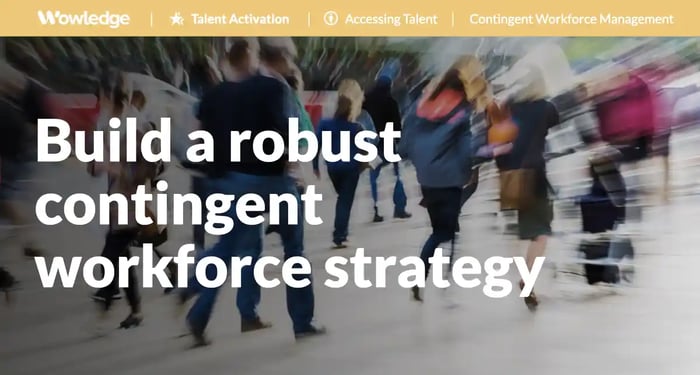Table of Contents
In the current workforce landscape, businesses are finding new ways to adapt their staffing needs. One crucial solution they're utilizing is hiring different types of contingent workers. These workers are not permanently employed but are hired for short-term projects or assignments. Therefore, understanding the key reasons why businesses increasingly rely on contingent workers, the current trends in their use, and the critical role that Human Resources (HR) and Talent Acquisition (TA) teams play in this shifting employment landscape have become essential for adequate business operation. Broadening the aperture, considering the issues related to the “future of work,” which the data suggests is currently upon us and impacting companies’ ability to properly and effectively staff their functions related to these flexible work arrangements, is also paramount.
A rising contingent workforce has accelerated in the United States and some reports suggest that it is about to skyrocket with key trends shaping this shift. This is partly due to the (sometimes severe) talent shortages across industries and job functions. Another significant trend is the growing gig economy, where people take on short-term jobs or "gigs" as freelancers, temps, independent contractors, and fractional specialists. This allows companies to tap into various skills and expertise when needed. Another trend is the rise of online platforms and apps that connect businesses directly with temporary workers quickly and efficiently. This digital connection makes it easier for companies and workers to find the right fit for their needs.
Data supports the view of an increasingly self-employed workforce. Dated reports from the U.S. Bureau of Labor Statistics (BLS) illustrate that about 10% of the working population is self-employed, while an additional 2% are employed by temporary agencies in any given week. That data, however, is clouded by several factors, including how often the BLS surveys this population segment and how respondents report their work arrangements themselves, with those employed with “side gigs” appearing vastly underreported. In contrast, a recent study conducted by McKinsey (and supported by similar figures reported by Statista) suggests that the volume of total contingent workers is as high as 36% of the U.S. workforce. This research asked survey respondents how they made their living and found that the vast majority cobbled together a living by combining contract, freelance, temp, and gig work. This is further supported by reports from the U.S. Government Accountability Office (GAO) stating that 40% of the U.S. workforce comprises contingent workers and that such workers comprise 18% of the average organization.
Remote work has become more common, opening opportunities for workers to take on tasks from anywhere in the country (or even beyond national borders). This shift towards remote work means companies can access talent from a broader pool while many contingent workers are looking for more flexibility in their work-life balance, which aligns with the demand for short-term roles. CNN reports that over five million (5M) workers have reported earnings from a platform-based job (e.g., DoorDash, Uber, Instacart), a significant increase from only a few years prior.
As businesses adapt to changing demands, hiring contingent workers is expected to continue to evolve, creating new opportunities for companies and individuals in the ever-shifting world of work.
Key reasons and advantages of contingent labor
Companies are fueling the rising contingent workforce due to several essential reasons. One key opportunity is flexibility. Contingent workers can be brought in when a company needs extra help, like during busy seasons (e.g., retail holiday shopping) or for specific projects, such as large technology system conversions, new product or service launches, related marketing campaigns, etc. This allows companies to adjust their workforce to match their current needs without the long-term commitment of hiring full-time employees.
Cost savings are another crucial factor. Hiring contingent workers can be more cost-effective because companies often don't need to provide them with benefits like health insurance, bonuses, other incentives, vacation, sick leave or other paid time off, and permanent office space. This can help businesses plan and manage their budgets more efficiently.
Additionally, companies use contingent labor to access specialized skills, such as fractional experts or leaders (CHRO, CFO, CMO, etc.), which represents another rising trend on its own. Sometimes, organizations need specialized expertise for a short-term project that their regular employees might lack or an insufficient number of appropriately skilled employees to conduct the necessary work. This is especially true as STEM-related labor shortages persist and more traditional industries increasingly rely on internet-based technologies, artificial intelligence, and robotics to design, develop, and produce critical work products and services. Contingent workers with unique skills can fill these gaps.
From the perspective of the contingent worker, the reasons for taking on such work and the associated advantages are typically linked to personal, lifestyle, and financial rationales. One of the critical factors is flexibility. Contingent jobs often offer the freedom to choose when and where they work, allowing them to balance their work and personal lives better. Many use such an arrangement to build a portfolio of skills and experiences they may not find while working in a single company or industry, such as those engaged in technology-related work. At the same time, some appreciate the variety of assignments and the chance to gain experience in different industries or roles. Others prefer this arrangement because it provides opportunities to explore their interests and skills, as contingent work can also be a way to enter the job market, especially for those just starting their careers or looking for part-time employment. While they may not have the same job security and benefits as full-time employees, the flexibility and diverse opportunities often make contingent work attractive to many.
The cost savings involved in using a contingent workforce vs. full-time employees
Hiring contingent (contractor, temp, gig, consultant, fractional, etc.) employees and full-time employees each come with their own set of cost implications, and the cost savings involved depend on various factors such as the specific job, industry, and duration of employment. That said, most organizations rely on a balance of regular and contingent workers to achieve their goals, including cost management. Those cost savings typically associated with contingents can include:
- Reduced Benefits Costs: Contingent workers typically do not receive the same benefits as full-time employees, such as health insurance, retirement plans, and paid time off.
- Lower Payroll Taxes: Employers may save on payroll taxes with contingent workers, who are often classified as independent contractors (e.g., 1099). Employers do not have to pay certain payroll taxes, like Social Security and Medicare, for these workers. However, when hired through an agency, those costs (plus a profit margin) may be passed along to the employer, resulting in a higher per-hour or equivalent rate.
- Flexibility: Contingent workers can be hired on a project-by-project basis, allowing flexibility in scaling the workforce up or down as needed. This can reduce labor costs during slow periods, such as slow or high-volume seasons.
- No Paid Time Off (PTO): Contingent workers are typically not entitled to paid time off, such as sick leave, holiday pay, vacation, or other PTO, which can result in cost savings compared to full-time employees.
- Reduced Onboarding and Training Costs: Training and onboarding costs may be lower for contingent employees since they are often hired for specific skills and require less initial training.
Considering the specific business needs and objectives is essential when deciding between contingent and full-time employees. In some cases, combining both may be the most cost-effective solution, allowing a company to maintain a core team of full-time employees while supplementing those with contingent workers during peak periods. Additionally, legal and regulatory considerations play a significant role in classifying workers. Hence, ensuring compliance with labor laws and regulations in the relevant jurisdiction(s) to avoid potential legal and financial repercussions is essential.

The role of HR and Talent Acquisition teams in contingent worker engagements
As the percentage of contingent workers can be as much as a fifth (20%) or more of an organization’s working population and is expected to increase, the specialized role and skillsets of the HR function are primed to make a significant contribution. Whereas in previous times, businesses relied exclusively upon the Procurement function to source and generate candidates for hiring managers, the increased volume can be absorbed by the HR and Talent Acquisition teams. As they hold significant roles in the planning, sourcing, evaluating, hiring, and overseeing the relationship between the company and workers within an organization, extending some or all of the contingent workforce management functions to HR often makes sense.
Initially, HR and Talent Acquisition leverage workforce planning capabilities and their existing relationships with hiring managers as experts to identify the organization's staffing needs and the specific skills required for a given project or duration. The role of Procurement remains critical as a partner with HR to source companies with the expertise and access to the proper volumes of candidates to supply the company's shorter-term staffing needs. Once HR provides the requirements, the Procurement professionals rely on their expertise to negotiate suitable terms, conditions, and labor rates from operational and financial affordability perspectives.
HR and Talent Acquisition can then be responsible for screening and evaluating the qualifications of potential contingent workers just as they do for candidates for regular positions. This includes reviewing resumes, conducting and/or coordinating interviews, and checking references. They assess candidates' skills, experience, and cultural fit to ensure they meet the organization's standards. Once the best candidates are chosen, HR may coordinate the hiring process with the Procurement team, which involves preparing contracts, negotiating compensation, and ensuring compliance with contractual and legal requirements.
HR can oversee the onboarding and orientation of contingent workers as well, ensuring they understand the company's policies and procedures. They also support the process whereby these workers access necessary resources and tools and are integrated into the team.
That said, it is critically vital that HR and line managers maintain a clear separation and distinction between regular employees and contingent workers from a record-keeping and treatment/management perspective to avoid running afoul of relevant labor laws. While modern vendor management systems (VMS) can now integrate with HR Information Systems (HRIS) for a compellingly total view of the worker base, record keeping must be kept separate. Their management must also be distinct from standard company policies and practices, including performance management, salary administration, and company events.
HR and Talent Acquisition teams can act as a bridge between the organization and its contingent workforce. They are responsible for sourcing, screening, hiring, and onboarding these temporary employees, thus ensuring that they contribute effectively to the organization's goals while complying with relevant labor laws and regulations.
Cautions regarding the use of a contingent workforce
Relying on hiring contingent labor comes with some issues that organizations must consider. One significant challenge is the potential lack of long-term commitment from contingent workers. Since they are not permanent employees, they might feel disconnected from the company's goals and values, leading to lower loyalty and motivation. As a result, steps should be taken to integrate such workers into the assigned teams, function, and broader organization to avoid negative fall-out, team productivity, or socialization issues related to their employment.
Additionally, managing a diverse contingent workforce with varying schedules and contracts can be complex and time-consuming, making it challenging to maintain consistent team dynamics. There's also the risk of legal and compliance issues if contingent workers are misclassified as independent contractors, which could lead to penalties. Finally, finding and onboarding new contingent workers for every project or task can be costly and time-intensive, impacting an organization's overall efficiency. Therefore, contingent labor offers flexibility but can also present engagement, management, and compliance challenges.
The challenges or issues that contingent workers face when they are hired to perform a job. Employment data demonstrates that immigrants, younger, and low-income workers dominate the contingent workforce. This trend seems likely to continue because many self-employed have multiple jobs simultaneously. However, the McKinsey research pointed to about one-third of its survey population earning more than $150,000 annually in roles such as lawyers, accountants, actors, writers, traveling nurses, social influencers, and fractional executives, among others.
Nonetheless, contingent workers face several challenges when hired for a task or project. First, job security can be uncertain because they often work on temporary contracts, which are subject to cancellation before the companies lay off their employees, making it harder to plan. Secondly, contingent workers often do not have access to the same benefits as full-time employees, such as health insurance, retirement plans, and paid time off, which can affect their financial stability and well-being. Additionally, they might experience inconsistent work hours and schedules, making it challenging to balance their personal lives. Recent research also suggests that 14% earned less than minimum wage, and 30% required food stamps to feed themselves/their families.
Many face challenges in building strong relationships with colleagues and feeling like a valued part of the team since they are not permanent members; in some companies that rely heavily and historically on the use of temps, consultants, and contractors, they are looked upon with disdain by their full-time counterparts. Lastly, there can be limited opportunities for skill development and career growth, as contingent workers typically do not receive the same onboarding, training, and advancement prospects as full-time employees. These challenges underscore the importance of recognizing and addressing the needs of contingent workers to ensure fair and equitable treatment in the workplace. An awareness of these challenges should be built into planning and management oversight of the employment of such workers.
Nonetheless, as the continuation of a rising contingent workforce is an inescapable trend, organizations need to take advantage of this evolving dynamic and proactively mitigate related issues to remain competitive. It is also an opportunity for HR to expand its influence and partnerships with the business to enhance how this contingent workforce is managed, increasing their alignment with business capability needs and providing them with a more consistent experience to maximize their impact across the organization.
Relevant Practices & Tools
Emerging Recruiting Strategy and Sourcing Practices to Streamline Talent Discovery. >
Exponential technologies such as Artificial intelligence (AI) continue to evolve in their application across functions and industries to solve complex problems... more »
Incorporating Non-employees into Future Planning for More Robust Staffing Strategies. >
Contingent workers, consultants, contractors, freelancers, and "gig" workers are terms used to describe individuals external to the organization... more »
Building "Future of Work" Considerations into Workforce Planning. >
The "Future of Work" is a construct that is based on three major components - forthcoming changes in work method ("what" is done), the makeup of the worker population... more »
Leveraging Outsourcing for Cost-effective Services and Solutions. >
A key element of planning HR strategies involves the decision to build internal capabilities vs. outsource those to a partner organization... more »
The Talent Gap Analysis Goal ID Tool: Capture Critical Role Staffing Challenges and “6Bs” Strategic Talent Management Responses. >
This tool incorporates the multi-source staffing strategy outlined by Dave Ulrich and others that references the “Buy, Build, Borrow, Bind, Bot, and Bounce” options... more »
FAQs
How should organizations decide whether a role is better filled by a contingent worker or a full-time employee?
Decision criteria should include the strategic sensitivity of the work, duration of need, demand variability, and skill scarcity. Project-based, cyclical, or experimental work with unclear long-term demand often fits contingent models. Roles tied to the development and management of core intellectual property, regulatory accountability, or ongoing customer relationships typically warrant full-time hiring. A simple portfolio view that classifies work by criticality and predictability helps standardize these choices.
What governance model best coordinates HR, Talent Acquisition, and Procurement for contingent labor?
An integrated “total workforce” council with defined decision rights aligns policy, process, and spend. HR and TA lead demand planning, quality standards, and onboarding; Procurement owns supplier strategy, contracts, and rate governance; Legal and Security set compliance and access controls. Shared KPIs and a quarterly review cadence prevent silos and non-integrated activities, decisions, and outcomes. A single playbook and contractor or vendor intake route reduce cycle time and rework.
How can organizations onboard contingent workers quickly without creating co-employment or misclassification risk?
Onboarding should be task-focused, time-bounded, and tied to contract deliverables rather than employment-like processes. Provide role essentials, including systems access, safety briefings, and confidentiality agreements, while excluding information related to employment benefits, performance appraisals, and company-wide programs reserved for employees. All management direction should flow through the supplier or statement of work when applicable. Contingent labor should have a separate and distinct set of temporary employment policies that support and are consistent with behavior expectations (e.g., harassment, IP and data protection, safety, security) and performance standards. Documentation must reflect production volume and quality, as well as project milestones and acceptance criteria, not personnel management.
How should organizations set and control pay rates for contractors and freelancers?
Rate cards anchored to market data by skill, level, and geography establish guardrails for requisitions and supplier bids. Competitive mini-bids within bands preserve flexibility while preventing outliers. Discounts for volume, tenure, and prompt payment can be negotiated at the master-service level. Periodic recalibration against market movements keeps access to scarce skills without overpaying.










